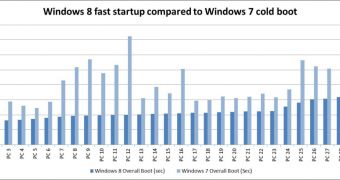The winner of the first Windows 8 vs. Windows 7 boot performance measuring contest is clear, and I doubt that we’ll ever see a comeback from Windows Vista’s successor in future comparisons.
An important aspect of Windows 8’s evolution is the fine tuning of the start-up process. Technologies such as solid state drive (SSDs) and Unified Extensible Firmware Interface (UEFI) aside, the next iteration of Windows comes with optimizations which will let Windows 7 in its boot dust.
Featuring a new start-up mechanism which combines cold boot with resuming from hibernate, Windows 8 delivers unmatched speed, drastically reducing the time it takes toreach Metro-ready or desktop-ready.
The next version of Windows closes user sessions on shutdown, but makes sure to hibernate the kernel session.
Only a small portion of memory is actually written to disk, it’s what the Redmond company calls, session 0 hibernation, as opposed to full hibernation.
“If you’re not familiar with hibernation, we’re effectively saving the system state and memory contents to a file on disk (hiberfil.sys) and then reading that back in on resume and restoring contents back to memory,” explained Gabe Aul, a director of program management in Windows.
“Using this technique with boot gives us a significant advantage for boot times, since reading the hiberfile in and reinitializing drivers is much faster on most systems (30-70% faster on most systems we’ve tested).”
The two graphics included with this article, courtesy of Microsoft, reveal the comparison between the new Windows 8 start boot and the old Windows 7 cold boot.
It’s rather obvious, that no matter the actual device customers will be running, it will deliver superior boot performance if it’s running Windows 8 as opposed to Windows 7.
“It’s faster because resuming the hibernated system session is comparatively less work than doing a full system initialization, but it’s also faster because we added a new multi-phase resume capability, which is able to use all of the cores in a multi-core system in parallel, to split the work of reading from the hiberfile and decompressing the contents,” Aul added.
Users can watch a video of Windows 8 booting on an EliteBook 8640p (Intel Core i7-2620M, 8GB, 160GB SSD) in just 8 seconds below.

 14 DAY TRIAL //
14 DAY TRIAL // 
